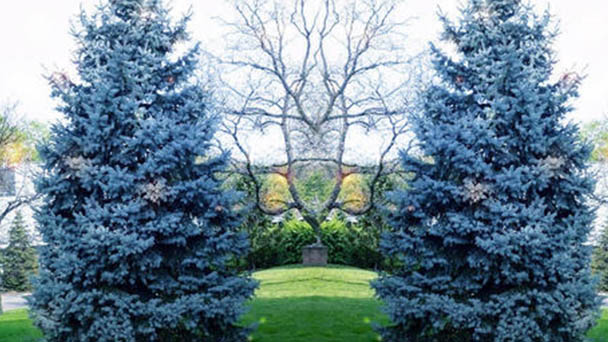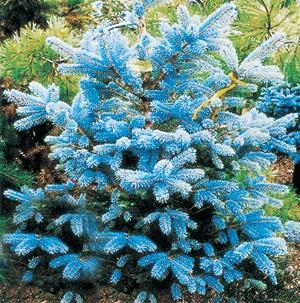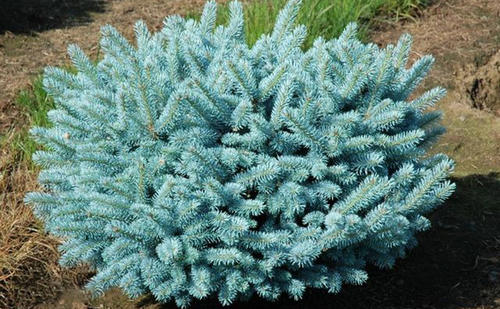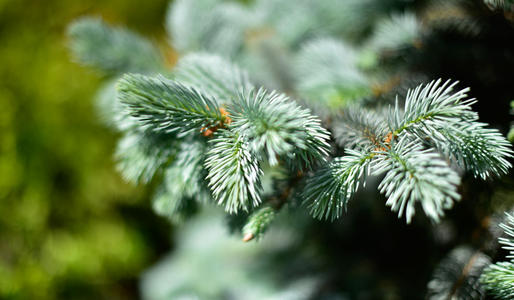Blue spruce (Picea pungens) profile
Written by Maggie
Mar 16 2021

Blue spruce (Picea pungens), also called green spruce, white spruce, Colorado spruce, or Colorado blue spruce, is an evergreen tree. Blue spruce height is 9 -- 15 m, crown width 3 -- 6 m. The tree form is columnar to pyramidal, and the structure is compact. Blue spruce has beautiful tree shape, rare blue leaf species, can be planted alone or in clusters in the courtyard, square, lawn, green space, building, etc., as a traditional European and American color leaf ornamental species, can also be potted in indoor ornamental.
Blue spruce picture

Blue spruce info
| Botanical Name | Picea pungens |
| Common Names | Blue Spruce, Green Spruce, White Spruce, Colorado Spruce, Colorado Blue Spruce |
| Plant Type | Spruce tree |
| Sun | Full sun |
| Hardiness Zones | 2 to 7 |
| Flower color | No flowers; silvery-blue needles |
| Native Area | From northern New Mexico through Colorado and Utah to Wyoming and into Alberta and British Columbia |
| Mature size | In the wild, it can grow up to 75 feet. In parks and gardens, it typically grows 30 to 60 feet high and 15 to 20 feet wide. |
Morphological characteristics of blue spruce
Blue Spruce can grow up to 30cm per year when transplanted, but the growth is slower in the years following transplantation. Newly raised leaflets in soft clusters, later becoming either sharp or obtuse needles. Leaves are less than 5 cm long, blue or blue-green.Flowers green, orange, or purple, spring bloom. Current branchlets are brown.
The ecological habits of blue spruce
Blue Spruce prefers cooler climates, moist, fertile and slightly acidic soils that grow well and require plenty of light. Blue spruce is slightly barren, drought and salt resistant medium, avoids high heat and pollution, cold resistance is strong, and can withstand the low temperature of -6℃.
Disease control of blue spruce
Blue Spruce is prone to cataplexy and blight during the seedling period, which requires regular spray to prevent the disease before it gets sick. Once the disease is found, the relevant pesticides can be used to spray treatment of the seedlings, and the disease seedlings will be pulled out to control the spread of the disease. Blue Spruce is drought-tolerant, but plants need to be watered properly when transplanted, or they will die due to drought.
The distribution of blue spruce
Blue Spruce originated in North America and is a traditional ornamental tree with colorful leaves in Europe and America.
Blue Spruce has been introduced into China and has been cultivated in Beijing, Shanghai, Guangzhou, Zhejiang, Hunan and other areas.
How to grow and care for blue spruce
Light
Plant blue spruce bushes in full sun, making sure they get at least 6 hours of unfiltered solar per day.
Soil
These timber are high-quality in a region with a moist, well-drained soil made fertile thru the use of soil amendments. However, the bushes can adapt to a range of soils, whether or not acidic, loamy, sandy, or clay. When it comes to soil pH, these timber select vary between 6.0 and 7.5, however they're capable to tolerate extraordinarily acidic or alkaline soils.
Water
Blue spruce is drought-tolerant and can live on in intervals of low water, however it does thrive with reasonable water levels. During the first season, water the tree commonly to hold the soil moist. Once the tree is established, water solely all through dry spells. Avoid water logging the tree or growing areas with standing water.
Temperature and humidity
The blue spruce is tolerant of bloodless weather. It can tolerate warmness to a point. However, it will no longer thrive in extraordinarily warm and humid climate conditions.
Fertilizer
Blue spruce no longer wants usual fertilization. You can fertilize them in the spring, earlier than the developing season, to provide the tree an delivered vitamin boost. It will possibly amplify the size of the desires and enhance the needle color. Sprinkle 10-10-10 slow-release granular fertilizer over the soil in the root zone, and fowl water with about two inches of water to stop fertilizer burn and include the fertilizer into the water.
Repotting
A developing style is to purchase Colorado blue spruce bushes in containers for indoor Christmas decorating, then plant them in the backyard as panorama flowers after the holiday. Dig the gap in the floor for planting nicely earlier than December, so you will no longer have to dig via frozen dirt. Bring the excavated dust inside, to hold it from freezing. This will assist to preserve it unfastened so that you will have attainable grime with which to fill in round the new specimen after transplanting it into its hole.
Pruning
Colorado blue spruce bushes do no longer want to be pruned, however they can be if you want to promote denser foliage. Prune off 1/2 of the sparkling increase on every candle (that is, the tip at which department increase happens every year) in spring. Apply two or three inches of backyard mulch round the vegetation (but no longer up towards the trunks) to assist preserve moisture in the soil.

Blue spruce pests & diseases
The two most frequent pests affecting blue spruce timber are aphids and the Cooley spruce gall adelgid. The former will purpose yellowish blotches on the needles, which may additionally have a sticky fabric on them, whilst the latter can be recognized through the presence of a cotton-like substance of the spruce's branches. Manage the pests with the aid of hiring an enterprise to spray a horticultural oil that might not endanger birds or humans.
The timber can additionally be affected by diseases, the most frequent and unfavorable of which is Cytospora canker. This fungal disorder generally impacts bushes that are 15 to 20 years or older and motives the needles to flip brown and drop from the branches. Cytospora canker is a stress-induced disease, so manipulate it through lowering possible stressors, such as enhancing soil quality.
Varieties of blue spruce
P. pungens 'Baby Blue Eyes': Semi-dwarf cultivar that grows 15 to 20 toes tall
P. pungens 'Bakeri': Features a deeper blue coloration and crows 12 to 20 toes high
P. pungens 'Glauca Globusa': Dwarf range that grows three to 5 ft excessive and three to 6 toes extensive and hardly ever produces cones
P. pungens 'Moerheimii': Grows to a medium height, with a most round 30 ft tall
P. pungens 'Montgomery': A dwarf range that grows 5 to 6 ft excessive and has dense, blue needles.
Landscape use of blue spruce
Colorado Blue Spruce is a rare tree with Blue leaves, which is unique in the pine family due to its unique color. It can be used for landscaping, and can be planted alone or in clusters to decorate or adjust the color of landscape, or planted on both sides of roads. Blue spruce is a traditional ornamental tree with colorful leaves in Europe and America, and has high ornamental value for gardening and economic planting. Colorado Blue spruce as landscaping, urban landscaping tree species in China just heat up, especially in some cold areas of three provinces in northeast China, the winter can retain foliage almost no color leaf tree species, in order to beautify the city, the cultivation Colorado Blue spruce became the first choice, is the next 5 to 10 years to replace common evergreen tree species of choice.

Latest Updated
- Benefits of Bugleweed - 7 Science-backed Health Benefits
- Bugleweed Dangers & Side Effects - Is It Poisonous?
- How to Plant Evergreen Trees - What You Should Know
- When to Plant Evergreens - Grow Guide for Evergreen Trees
- 12 Wonderful Evergreen Shrubs for Your Garden
- 12 Popular Evergreen Plants with Pictures for Beginners
- When And How To Prune A Lilac Bush Like a Pro
- How to Grow & Care for Lilac Vine (Hardenbergia Violacea)
- Japanese Lilac Tree (Syringa Reticulata) Care & Propagation Guide
- Shumard Oak Pros and Cons - What to Know
Popular Articles
- Winter maintenance of Antirrhinum Majus
- How to Grow Terminalia Mantaly Tree
- How to Grow and Care for Crossostephium Chinense
- How to grow Antirrhinum Majus in spring
- Peristeria Elata (Dove Orchid) Profile: Info & Care Guide
- Underwatered Snake Plant (Sansevieria Trifasciata) - Signs And How To Fix
- How to Care for Brazilian Jasmine Plant (Mandevilla Sanderi)
- How to Grow & Care for Graptopetalum Purple Delight in Summer
- Rosa Chinensis (China Rose): Plant Growing & Care Tips
- How to Care for Baby Sun Rose (Aptenia Cordifolia)